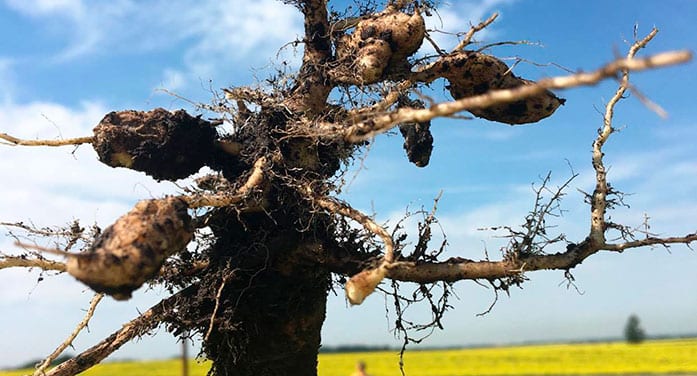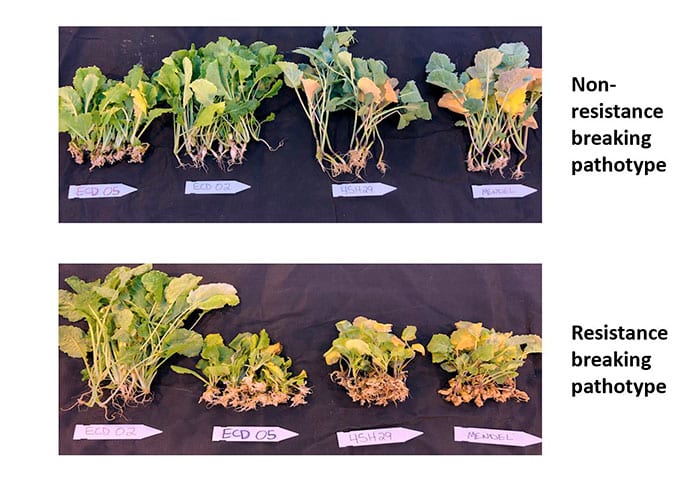
U of A researchers identified nine new strains of clubroot, a disease that affects canola plants, in Western Canadian fields in 2017 and 2018. The discovery shows the number of clubroot strains that can overcome genetic resistance bred into canola plants is on the rise. (Photo: Supplied)
Nine new strains of clubroot – a disease that can kill canola crops – have been discovered in Western Canadian fields.
While that’s not good news for producers, the discovery shows how important it is to build a multi-pronged strategy for protecting their crops, not relying solely on canola plants bred to resist the disease, said University of Alberta lead researcher Keisha Hollman.
| RELATED CONTENT |
| $1.25-million project tackles clubroot resistance in canola By Bev Betkowski |
| Canola conundrum puts Canada in China’s crosshairs By Sylvain Charlebois |
| Research project explores new way to boost canola production By Bev Betkowski |
The discovery of the new pathogens in canola fields tested across Alberta, Saskatchewan and Manitoba in 2017 and 2018 means resistance breakdown first discovered in 2013 is growing.
“We can’t just rely on genetic resistance. There’s no silver bullet control; it’s more about multiple strategies,” said Hollman, who led the study to earn her master of science degree in the Faculty of Agricultural, Life & Environmental Sciences.
“We can mould the future in a way that is going to protect the canola industry. Now that we know about this resistance breakdown, we can think about how we’re going to protect the longevity of new and current resistant sources.”
The research, published in the Canadian Journal of Plant Pathology, brings the number of known clubroot pathotypes to 36, of which 19 can overcome the “first-generation” resistance to clubroot found in most canola varieties grown in Canada.
“It shows how diverse the virulence of these pathogens is, and that this is going to continue to be a problem.”
Multiple strains of clubroot can occur in a field at any given time, so can overtake the pathotype that canola was originally bred to resist.
“We’re growing the same resistance source over and over again, and that’s giving these other strains living in the soil the opportunity to grow their population,” Hollman explained. “That means there’s a new dominant pathotype in the field, which first-generation resistance can’t control.”

The discovery of nine new strains of clubroot brings the number of known pathotypes to 36, including 19 that can overcome the resistance to clubroot found in most canola varieties grown in Canada. (Photo: Supplied)
Clubroot is caused by a parasite that infests field soil with resting spores that can survive up to 20 years. Canola and related plants such as cabbage that are grown in the infested soil develop tumours on the roots, which block water and nutrient uptake, causing stunted growth, yellowing, wilting and, in worst cases, death of the plant. Listed under Alberta’s Agricultural Pests Act, clubroot can cause anywhere from 60 to 90 per cent canola crop yield loss in an industry that is worth $26.7 billion annually in Canada.
“To find these virulent pathotypes is a disturbing situation for farmers because a relied-upon management tool—using genetically resistant canola seed – has been undermined,” said Hollman, who added it can take a decade to develop new clubroot-resistant canola plants.
Additional methods need to become more a part of an overall strategy to prevent and manage clubroot infestation, she added, noting that such plans are becoming a requirement for any type of third-party development on agricultural land, such as reclamation.
Management plans could include longer rotations out of canola, sanitizing farm and other field equipment between fields, and potentially the application of lime and other soil amendments to discourage clubroot development. A U of A study published in 2019 showed that after a two-year break from growing canola, the number of clubroot spores decreased by about 90 per cent in field soil, Hollman noted.
Hollman’s research was also able to identify where particular new strains are popping up, whether they were spreading rapidly and why, which gives producers a headstart on dealing with clubroot infestation by tailoring their management strategies.
“We found a lot of the new pathotypes were isolated, so mapping them is a benefit. We hope to contain them in the area and keep them from spreading further.”
The identification of the new pathotypes also helps plant scientists by detailing the virulence of each strain. “It helps focus breeding efforts towards the most dominant new pathotypes.”
| By Bev Betkowski
Bev is a reporter with the University of Alberta’s Folio online magazine. The University of Alberta is a Troy Media Editorial Content Provider Partner.
The opinions expressed by our columnists and contributors are theirs alone and do not inherently or expressly reflect the views of our publication.
© Troy Media
Troy Media is an editorial content provider to media outlets and its own hosted community news outlets across Canada.

